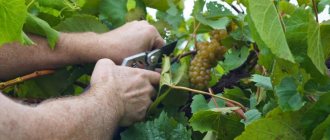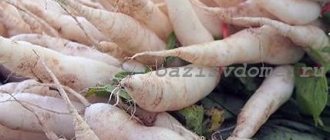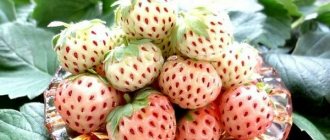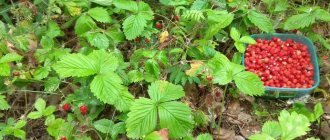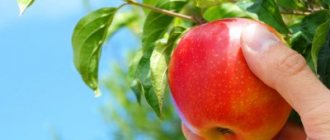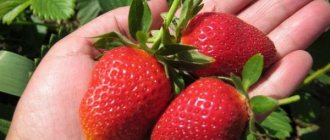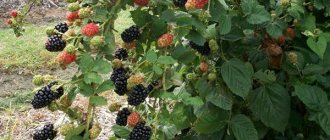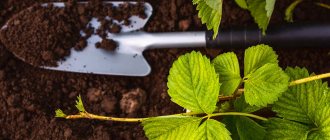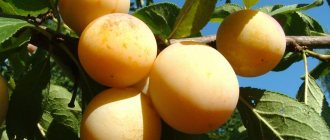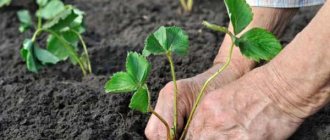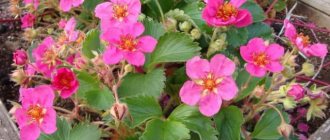Useful substances and properties
Strawberries have long been famous for their beneficial properties for the human body, since its leaves contain a large number of chemical elements and organic acids, its flowers contain many vitamins in one element - rutin, and its fruits contain vitamins, minerals, acids, macro- and microelements, tannins, pectins and natural sugars.
In general, when consuming wild strawberries, the beneficial substances contained in them have the following beneficial effects: diuretic, tonic, diaphoretic, anti-inflammatory, tonic and vasodilator.
Krasnika
Why it is useful: Redberry berries and juice lower blood pressure, they are rich in vitamin P, which dilates blood vessels and strengthens their walls. In addition, redberry contains vitamin C, organic acids, essential amino acids, fiber, and minerals. It is useful for colds and infections, to improve digestion. The young leaves of the plant are also eaten.
When to pick: Krasnika is a northern berry that grows in Kamchatka and Sakhalin; it is harvested in August-September. It has a peculiar taste: at first it is sweet, then it becomes sour, and at the end it acquires a bitterness.
Where to find?
Strawberries, as mentioned above, grow in unshaded places. Of course, it can also be found in the forest, but then it will be adjacent to a lit lawn or a place where trees have fallen due to the wind, and a gap has formed. In the forest, bushes should be looked for in the following places:
- at the edge of the forest;
- in the clearings;
- in places with a lot of dead wood;
- in clusters of bushes;
- in young groves, where tree crowns do not yet absorb all the sunlight.
It should be noted that the juiciest and healthiest berries grow where there is the most sun. At the same time, excessive aridity of the area does not benefit the culture. When picking berries in brightly lit meadows, it is recommended to immediately try the strawberries. It may be overdried, especially if there was little rain during the summer season.
To get the best harvest, it should be collected in locations that combine moist, but not waterlogged soil and plenty of sunlight.
Wild strawberries can also be found in the field, where they are usually smaller than in the forest, since the field area is initially less wet than the forest area, but the berries ripen faster here. If you want to collect fruits with sourness, it is best to look for them in the field. In field conditions, strawberries rarely grow among ears of rye, wheat and other grain crops. It cannot be found on plowed land planted with industrial crops - beets, potatoes, cabbage.
To grow, strawberries require wild conditions, unplowed land and a fairly dense, but not too high, herbaceous environment. The optimal conditions for growing in the field are clusters of weeds: they protect the fruit crop from burning, if there is excess moisture in the summer, and save the berries from excessive wateriness.
Late ripening varieties
The ripening time for late strawberries is July and August.
Great Britain
Large-fruited Great Britain is breaking all records in terms of yield. Prevent diseases, provide proper care - and you can collect up to 4 kg from a bush. Burgundy-cherry berries have a sweet, fleshy pulp - they make delicious jams and preserves.
Gigantella Maxim
This Dutch plant successfully lives up to its name: its bushes reach half a meter in height, and its berries grow the size of an apricot. Of course, with the right agricultural technology. Gigantella loves light, but cannot stand the sun, and gets sick in rainy weather. At the same time, she loves moisture and needs regular watering. It is demanding on soil and grows best after legume green manure.
Lord
This variety came to us from Britain back in the 80s and is still popular today. Grows best in temperate climates. It is resistant to frost and drought, but suffers from extreme heat. The berries are large, round, with dense sweet pulp. They don't last long - they need to be eaten, processed or frozen within three days.
Malvina
The German variety Malvina is classified as a dessert variety due to the high concentration of sugar in the fruit. The berries are large and very dense, cherry color, with a bright aroma. Withstands frosts down to -19 degrees, in the middle zone it grows well under cover. The bushes grow very large, so plant them at a distance from each other.
Pegasus
Pegasus is very prolific: one bush brings about 2 kg of harvest. It loves the sun and black soil, is not afraid of cold weather and is resistant to diseases and pests. Beautiful glossy berries grow up to 45 g, have a fragrant aroma and sweet taste - the variety is considered a dessert variety.
Roxana
We have a lot of Italian women today, and this one is one of the best in the selection. Roxana's dessert berries are elongated, have a strawberry aroma and grow up to 120 g. One bush produces more than a kilogram of fruit. Withstands frosts down to -20, and with shelter under a layer of snow - up to -30. It resists pests and putrefactive diseases well.
CHamora Turusi
The peculiarity of the variety is the size of the berries: in the first year of fruiting they reach 100-150 g. Then they become smaller to 30-70 g, but their number increases. The fruits are red or purple, with a wonderful taste and aroma, and come in various shapes. In the central zone it winters well even without shelter; it does not like heat or drought. Prevention from diseases is necessary.
When the dugout blooms and ripens
Strawberries begin to bloom in May. In the northern regions later - at the beginning of June. The lifespan of one flower is 4-6 days. After this, a berry is formed.
When strawberries ripen
A common question is how long before ripe fruit can be harvested. It takes 3-4 weeks to ripen. The collection period lasts about the same. The berries do not ripen simultaneously, but in stages. Therefore, even in one clearing you can regularly pick fragrant strawberries.
Interesting fact. When the strawberries are ripe, sellers with fresh berries appear along the roads and in markets. Some people determine that it is time to go into the forest.
Medium ripening varieties
Strawberries of mid-season varieties bear fruit in mid-summer: from late June to late July in the northern regions and throughout June in the southern regions.
Asia
An Italian variety, very demanding on climatic and soil conditions - it can only grow in the southern regions. The berries and pulp are bright red, fresh-sweet and juicy. The first fruits reach 70 g, the subsequent ones - up to 40 g. Asia is vulnerable to powdery mildew and other diseases - preventive measures are mandatory.
Crown
A variety of Dutch origin with heart-shaped fruits weighing 15-30 g. The berries are fleshy, juicy, fragrant and sweet. The density is average - you won’t find a better one for making jam or preserves. The crown can withstand frosts down to -22 degrees. Resistant to fungal diseases, but susceptible to others. Productivity – up to a kilogram per bush.
Merchant's wife
Kupchikha is otherwise called zemklunikaya - it is a strawberry-strawberry hybrid bred by domestic breeders. The size of the berries is from 3.7 to 25 g, the color is wine-purple, the shape is elongated and bizarre. The fruits have sweet, low-juicy pulp with a nutmeg aroma. The variety is highly resistant - it is not afraid of frost, drought, or disease. One bush produces up to 300 g of harvest per season.
Sensation
A young Dutch variety with high productivity - up to 1.8 kg of berries are harvested from a bush. The first fruits are large and reach 60-90 g, the main harvest is 20-22 kg. The shape is round, the color is red-pink or red-orange. The taste of Sensation is sweet, soft and juicy - some gardeners compare it with Gigantella. This strawberry tolerates frost and drought well and is moderately resistant to diseases.
Florence
The Englishwoman Florence produces 500 g of harvest per bush per season. The fruits are sweet and aromatic, on average reaching 30-40 g, maximum 60 g. Resistant to unfavorable climate, grows in any soil and is almost not susceptible to diseases of the root system. It does not like heat and requires abundant watering.
Queen
Dessert domestic variety. It is not afraid of drought and heat, is moderately resistant to frost, and resists diseases well - with the exception of verticillium. 350-1000 g of berries weighing 12-50 g ripen on the bush. Lack of moisture affects the size of the fruits - they become smaller. The berries are sweet and sour, rich red in color, conical in shape.
Black Prince
This Italian got its name for the unusual color of the fruit - burgundy-red, almost black. The variety is high-yielding with a fruit weight of up to 50 g. It tolerates frosts down to -18, and has average resistance to drought. It bears fruit for 6-7 years and even more with good agricultural technology. The berries have medicinal properties due to the concentration of vitamin C and phytoncides.
Elsanta
An unpretentious Dutch variety with glossy red fruits and pulp of the same color. The berries are dense, sweet and sour. It tolerates winter well, drought - moderately. It is not afraid of many fungal diseases, but it is vulnerable to powdery mildew. Productivity – up to one and a half kilograms per bush.
Taste of fruits
When strawberries ripen, at first the fruits have a sour, slightly bitter taste, but this is normal for wild strawberries. When the next wave ripens, the taste becomes sweeter than the previous one and the bitterness disappears. Subsequent berries have an even more pronounced sweet taste.
The taste of the berries also depends on the weather conditions under which the strawberries ripened. If the summer is rainy, the berry becomes unpleasant to the taste, too soft and watery. Picking such berries is bad, as they turn into mush in your hands.
In dry summers, when wild strawberries ripen, the fruits become small and dry. Under fairly normal summer conditions, strawberries look tasty and appetizing, the berries are beautifully shaped, have an even color, are juicy and aromatic.
How to avoid getting caught in weedy strawberries
Sometimes an inexperienced gardener may accidentally acquire weedy strawberry varieties. These can be Suspension, Bakhmutka, Zhmurka, Dubnyak. According to the nature of growth, such strawberries are characterized by aggressive reproduction and a powerful vegetative system. Such plants will not be able to produce a harvest if you do not take care of them.
Some representatives of weedy strawberries do not bloom at all, others bloom but do not set. If berries appear, they are small and tasteless. A distinctive feature of this type of plant is its powerful root system and active growth of bushes. The plant produces a lot of tendrils and takes root well, but you can’t expect a harvest from such strawberries. Moreover, as weed strawberries multiply, they suffocate the cultivated species, gradually displacing them from the site. Such aggressive specimens must be uprooted immediately.
First harvest after planting
First, planted strawberries direct all their energy to developing the root system and forming a bush, so you should not count on a good harvest immediately after planting.
The ripening time for strawberry fruits from the beginning of flowering is 4–5 weeks . This period can be either accelerated or slowed down - it all depends on care and weather conditions.
The following two tabs change content below.
Depending on the speed of berry ripening, all varieties are divided into 4 categories.
| Category | Varieties | First harvest |
| Early | Honey, Anita, Alba, Zarya, Kimberly, Olvia, Clery | mid and second half of May |
| Mid-early | Corona, Festival, Capital, Ellis, Elsanta | the beginning of June |
| Mid-late | Nightingale, Asia, Queen, Arosa, Present | mid and second half of June |
| Late | Tarusa, Adria, Pegasus, Chamora | mid July |
Remontant varieties, which are capable of producing not just one, but several harvests per season, are also included in a separate category. These include, for example:
- Elizabeth 2;
- Gigantella;
- Albion;
- Selva et al.
They bear fruit in May, throughout the summer and even in early autumn.
Remontant strawberries produce the most abundant harvest at the end of summer.
Acceleration of the maturation process
To speed up the process, you should create the most favorable conditions for strawberries based on the following rules:
- Do not keep seedlings in the same place more than 5 years.
Periodic replanting is an important part of the agricultural technology for growing strawberries and is carried out with the aim of rejuvenating the plantings.
- Get rid of “weedy” strawberries, the seeds of which may accidentally end up in the mixture with the seeds of the main crop - for example, Dubnyak, Podveska, Zhmurka, etc.
- Choose the right place – well lit from all sides, but at the same time closed from drafts.
All varieties of strawberries love well-lit areas.
- Strictly observe the timing of planting seeds for seedlings (in the Middle Zone January - February, in Siberia and the Urals - March).
- Plant seedlings exactly on time - there should no longer be a threat of frost on the soil; each seedling must have at least 5 leaves, and the neck must be at least 6 mm in diameter.
- Provide cover with film in case of cold weather and heavy rains (strawberries do not like excess moisture).
Even the simplest greenhouse saves strawberries from bad weather and speeds up the ripening of the berries.
- Provide sufficient, but not excessive watering ( norm 10 liters per 1 m2 ).
- Apply fertilizer regularly: this is usually done in 5 stages : fertilizing is applied for seedlings, before flowering, during the formation of ovaries, during the period of fruit appearance and growth, and also after harvesting.
Follow collection deadlines
The strawberry variety fund is seriously diversified. It has early-, mid- and late-ripening varieties, which allows you not only to obtain a fresh harvest for a longer time, but also to evenly distribute the effort. The very first harvests can be obtained already in the second half of May, and with the so-called. Day-neutral varieties can produce fresh berries until December.
Of course, many factors influence the speed of berry ripening:
- temperature conditions;
- frequency and volume of irrigation;
- frequency of application and composition of fertilizing and fertilizers;
- age and condition of plants;
- pollination efficiency, etc.
Therefore, from year to year, ripening times may differ within a certain range. Thus, determining when it is best to pick strawberries has to be done individually each time. In order not to miss the moment, you need to organize a system for monitoring the condition of the future harvest. Strawberries are considered fully ripe when the berries are completely red, including the tips, but still retain their shape and have not softened. Moreover, even on the same plant, berries, as a rule, ripen at different rates. Therefore, the plantation will require daily attention.
Another important detail is that ripe berries of different varieties retain their density differently. Some remain quite hard for a long time, so they can be collected after full ripening. Others almost immediately begin to soften, so they can be collected slightly under-conditioned.
Harvesting on time is important for many reasons:
- overripe fruits are stored worse;
- taste also changes over time;
- While the ripe fruit is on the plant, it takes away some of the nutrients and water, which slows down the ripening of other berries.
In addition, overripe berries can ferment, mold and other fungi may appear on them - and this is already a threat to the condition of the entire plantation.
What ripens first: strawberries or wild strawberries?
Strawberries and wild strawberries are related plants, but there has been confusion with their names. The berry that people are used to calling strawberries is actually correctly called garden strawberries. There is also a wild berry, which is called strawberry.
For the convenience of the reader, further on garden strawberries will be called strawberries, as all amateur gardeners are accustomed to doing, and wild forest and field berries will remain strawberries.
In terms of ripening time, wild strawberries are slightly behind strawberries. This is explained by the fact that it grows in the shade of trees, which delays ripening by half a month. If strawberries grew in a sunny meadow, then they can ripen earlier than their garden relatives.
About the strawberry season: in Russia, in its mid-latitudes, the strawberry season occurs in mid-June and lasts from two weeks to a month. In the southern regions, the beginning of the harvest may shift to the end of May, and in the northern regions - to the beginning of July.
When do meadow strawberries ripen?
When strawberries ripen in Crimea
When do wild field strawberries ripen? Meadow and field strawberries ripen earlier than forest ones, due to the fact that they receive more sunlight, but are inferior to forest ones in size and juiciness of the berries.
Forest uncultivated strawberries are quite suitable for transplanting and growing in the garden and do not require any special care. Moreover, it will ripen half a month earlier than the one growing in the neighboring forest from where it was transplanted.
The decisive factor in the start of the period when strawberries ripen is the air temperature. If at the initial stage of growth a sufficient temperature may be +2...+5 degrees Celsius, then during the ripening period daytime temperatures should reach from +20 to +24 degrees, and night temperatures from +14 to +17 degrees.
Meadow strawberry
How to organize care to get a good strawberry harvest
In order for garden strawberries to produce a good harvest, you need to take care of this in advance and create all the proper conditions for its growth. Strawberries are not a capricious crop; they do not require care. All that is needed is proper watering, timely fertilizing and protection from frost.
When to plant strawberries and how to choose seedlings
Strawberries are planted at the end of July. The most suitable period is from the end of July to August 10. The later the plant is planted, the better harvest it will bring next year. Still, you shouldn’t delay the planting procedure until mid-August. It is better to plant strawberries in the evening.
Overnight, the plant acclimatizes to its new location. Ready-made strawberry seedlings are purchased in specialized stores. You can prepare it yourself if there are already strawberry bushes on the site. Planting material should be prepared during harvest, paying attention to the quality of the berries ripened on a particular bush.
The best bushes need to be marked in some way; you can stick a small peg next to it. Next year, you can pinch off a rosette from this bush and plant it in a new area. You can plant several varieties of strawberries, but then each variety of berries should have a separate bed.
What soil is suitable for strawberries
Before you start planting strawberries, you need to properly prepare the soil. For this berry, soil with the following characteristics is suitable:
- slightly acidic
- sandy loam
- loamy
A berry grown on sandy and clay soils will be small because it will not have enough moisture; excess moisture is also harmful. The basic composition of the soil may look like this:
- turf soil
- sand
- peat
- wood ash
- vermicompost
Humus, peat, and turf are taken in equal proportions, then a small amount of sand is added there. Before planting, the soil is carefully dug up, fertilized, and humus is added. It will take two or three weeks for the soil to compact. Only then will it be possible to begin planting.
Landing place
For strawberries, you need to choose a sufficiently lit place. It requires sunlight; even a little shade can affect the quality of the crop. In this case, you need to pay attention that tomatoes or potatoes do not grow nearby, since strawberries have diseases similar to them.
The places where beans, peas, onions or garlic previously grew are best suited. The planting area must be level. In the lower reaches the berry will grow poorly. If the plot is located near groundwater, then it should be raised. The height of the bed in this case should be about 40 cm.
If the soil is dry, there is no need to raise the beds high; 15 cm will be enough. The most suitable areas are those located in the southwestern part of the garden plot. Steep slopes are not suitable for this crop. In addition, the place must be protected from winds.
The berry can grow in one place for no more than five years. After this period, another area is selected for the berries. Strawberry yield depends on its age. The first and second years will be the most productive; in the third year the harvest will be good, but the berries will become smaller.
Over the next two years, the number of fruits will gradually decrease. If desired, after three years the strawberries can be dug up with roots and burned, and vegetables can be planted in their place. After three years, strawberries can be planted again in the same area.
Planting strawberries
Strawberries reproduce by rosettes that form on the tendrils of the mother bushes; the closer the rosette is to the mother bush, the better. Up to five rosettes can be grown on one tendril. Berries should not form on the mother bushes; as soon as flowers appear, they should be removed. Bushes of the second year of life are best suited for propagation.
A rosette with several leaves and roots is separated from the mother bush. After this, it is planted in the ground. Planting work is carried out in the evening or in cloudy weather, so that the plants do not die from the bright sun, but have time to take root well.
When forming a bed, it is necessary to maintain a certain distance, both between the ridges and between the bushes. A distance of about 90 cm is maintained between the beds, and the bushes are placed 30 cm from each other.
The procedure for planting strawberries is as follows:
- make a small indentation
- a small mound is formed in the hole
- a rosette is planted on a mound
- roots are sprinkled with soil
After planting, the strawberry rosette should be watered. This is done carefully so as not to flood the plant. For this procedure, use a watering can or sprinkling method. By the onset of winter, the seedlings will have time to acclimatize well. Next summer the strawberries will begin to bear fruit. To protect the plantings from harmful insects, lupins can be planted nearby.
Plant care
After the strawberry bushes have been planted, efforts must be made to ensure that they take root well; to do this, they are covered with sheets of paper and periodically sprayed. Strawberries need water, otherwise the plant may dry out; watering must be done regularly, without allowing excess moisture.
On hot days, water the plants once every four days, and in cloudy weather once a week will be sufficient. There should be at least 5 liters of water per square meter. In general, you should focus on weather conditions and water as needed. Strawberries need to be watered in the morning.
In general, plant care is not complicated; it includes the following procedures:
- weeding
- cleaning the area from harmful insects
- mulching
- feeding
Mulching is a necessary procedure for strawberries. By mulching you can prevent moisture evaporation. The best mulching material for this berry is pine needles; if there are no pine needles, you can use mowed grass. In August you will need to loosen the soil to a depth of 5 cm.
You need to feed strawberries three times a season:
- The first fertilizing is done in the spring, before flowering begins.
- The second time strawberries are fertilized during the fruiting period
- Third time - in the fall
Vermicompost is suitable as a fertilizer; it contains the nutrients necessary for strawberries: phosphorus and potassium. The fertilizer also contains phytohormones, which accelerate plant growth, and antibacterial and antifungal substances. In spring, strawberry bushes begin to prepare for the season.
Dried and diseased leaves should be removed. The soil around the bushes should be loosened well. When the first young leaves sprout, the old foliage can be completely removed. It is recommended to do pest prevention. To do this, prepare a one percent solution of copper sulfate.
Strawberries are poured with this product, and a week later the berries are treated with potassium permanganate. This method will destroy the larvae of harmful insects. When the strawberries begin to bloom, they also need to be treated with a light pink solution of potassium permanganate, to which 0.5% boric acid is added.
Along with the berries, tendrils also begin to grow on the bushes. They should be removed throughout the entire fruiting period. With proper care, strawberries actively bear fruit from May to October. Strawberries are very sensitive to frost; at temperatures below 12 degrees, their delicate roots can freeze. Therefore, the berries are prepared in advance for wintering.
To do this, in October the bushes are sprinkled with spruce needles and sawdust, and the soil is first mulched with peat. And when the first snow falls, it will need to be compacted. The snow layer should be at least 10 cm. In spring, the layer of soil and sawdust is carefully removed.
about strawberry varieties that always produce a harvest:
Source: https://OgorodSadovod.com/entry/3149-kak-nuzhno-organizovat-ukhod-chtoby-poluchit-khoroshii-urozhai-klubniki
The nuances of growing wild strawberries in the garden
Recently, very often gardeners refuse to grow wild strawberries in their gardens, since large-fruited garden varieties are considered more attractive. However, there are those who still consider wild strawberries to be a more attractive, unpretentious, disease-resistant plant. It is also perfect for the Moscow region climate.
Growing wild strawberries in the garden
Planting strawberries in your garden takes place in several stages:
- Preparing the soil at the site for planting.
- Preparing strawberry seedlings.
- Planting seedlings in open ground.
- Further care of seedlings.
During the first stage, it is important to find the most favorable area for strawberry growth. Experienced gardeners do not recommend planting wild strawberries on hills, since in winter strong frosty winds will blow there and the plant will freeze
The soil should be slightly acidic, neutral with an optimal amount of humus. Approval must be applied to the selected area: manure, compost or humus, superphosphate and potassium sulfate. Then everything is dug up and left for the winter. In the spring everything is dug up again.
At the second stage, annual or biennial strawberry bushes are found in the forest, and the first and second rosettes are taken from their tendrils. It is worth taking those tendrils that are closest to the mother plant, as they take root faster and will have a higher yield. Then they are planted for growing on growing beds.
During this period, it is important to monitor and care for the seedlings: water, weed and loosen the soil
At the beginning of September, the next stage begins: the seedlings are planted in open ground. Each seedling is placed at a distance of 30 cm from each other. A depression is created, the plant is lowered into it, covered with earth and pressed tightly with your hands.
Note! When planting, you need to place the tip of the bud at soil level and water the plant generously afterwards. Caring for strawberries does not end after planting
It is necessary to monitor the growth of seedlings and properly care for them: remove weeds, water, loosen the soil, mulch the soil so that moisture remains in the soil longer. In spring, all dry leaves of the plant are removed
After planting, caring for strawberries does not end. It is necessary to monitor the growth of seedlings and properly care for them: remove weeds, water, loosen the soil, mulch the soil so that moisture remains in the soil longer. In spring, all dry leaves of the plant are removed.
Important! For a bountiful harvest in the future, you need to water the plant abundantly after each flowering, fruiting and berry picking in mid-September. Wild strawberries should also be fed regularly.
The first feeding of mullein, superphosphate and wood ash is carried out in late April - early May. The second time you need to feed with wood ash and superphosphate before flowering. Next, the strawberries are fed with ammonium nitrate or ammonium sulfate after harvest. Its composition can be replaced with fertilizer made from diluted slurry. The last time of the year fertilizing is carried out at the end of August - beginning of September with mineral fertilizers. Superphosphate and potassium salt are suitable for these purposes.
Wild strawberries should also be fed regularly. The first feeding of mullein, superphosphate and wood ash is carried out in late April - early May. The second time you need to feed with wood ash and superphosphate before flowering. Next, the strawberries are fed with ammonium nitrate or ammonium sulfate after harvest. Its composition can be replaced with fertilizer made from diluted slurry. The last time of the year fertilizing is carried out at the end of August - beginning of September with mineral fertilizers. Superphosphate and potassium salt are suitable for these purposes.
Where to pick strawberries?
To get enough berries, you need to know the places where strawberries grow.
If we look at it globally, there are a lot of strawberries in Eurasia, especially in Russia. The berries are found in North and South America; they are rare, but they are also found in the countries of North Africa.
If you look for places within a small area (for example, a region), then strawberries are found in green fields and forest edges. Very often shoots grow in a dense layer throughout the clearing.
You can also find sweet fruits on forest edges and within the forest belt. Many berries can be found in sparse, light forests.
Strawberries also grow in the Moscow region, where forests and abandoned fields are located. There are a lot of berries in this region. Moreover, its fruits are larger than usual and juicier.
But when to pick strawberries in the Moscow region and other regions?
Choosing a variety
Experienced gardeners advise changing strawberry varieties systematically. This is due not only to the acquisition of experience, but also to the fact that pests adapt to special means of controlling them. In addition, breeders regularly develop new varieties.
Over time, new and improved types appear on the market. Choosing the right variety for planting is half the success. After all, each variety has certain characteristics, more or less suitable for a site in an area with climatic conditions and soil type.
The best solution would be to buy several varieties, test them and draw the appropriate conclusions. The variety you like can be propagated on your site.
Strawberries or wild strawberries: what's the difference?
An interesting fact is that many people call large garden strawberries strawberries, although this is not true. Let's figure out what strawberries and wild strawberries look like, and what is their main difference.
- The fruits of garden strawberries are large and fleshy. The weight of the berries can reach 25 grams. But wild strawberries, on the contrary, are small and heart-shaped.
- Cultivated strawberries have greater juiciness, richness of flavor with a bit of pleasant sourness. Wild strawberries have slightly dry fruits, but, compared to garden strawberries, they are sweeter.
- Garden strawberries begin to ripen in the first half of June, when there are practically no berries yet.
- Differences exist not only in the fruits. During the flowering period, strawberries develop both male and female flowers: some have only stamens, others only pistils.
- Garden strawberries bear more fruit than wild strawberries and strawberries, and can bear fruit for at least 5 years without replanting. Strawberries are less fruitful and therefore should not be attempted in home gardens. She won't get used to it.
- The shape of garden strawberries is round, while that of strawberries is more elongated.
- Where do wild and garden strawberries grow? This is obvious from the names of the varieties.
Remontant strawberry
Remontant strawberries are a domesticated crop that has a longer period of fruiting and flowering compared to wild ones. Domesticated bushes are slightly larger, as are the berries on them. Due to this, the taste of remontant strawberries is less rich, but sweeter.
If strawberries are grown under a transparent film, they can ripen as early as the beginning of June. The fruits are sour, but this is normal for the “first wave” of both wild and domesticated crops. Next come sweeter and richer berries.
It is the remontant strawberries grown under film that are most often sold at the beginning of the summer season. It can be distinguished by its larger fruits and the absence of the strong aroma that is inherent in wild berries.
The fruiting period of remontant strawberries depends on the conditions of their care. The more mineral fertilizers, sunlight and water (but without waterlogging the area) it receives, the better the development of the ovaries, which will become fruits in the future. With proper care of strawberries, you can achieve a harvest for the entire summer season and even for September, if the first month of autumn is warm.
When the strawberries are ripe
When do cherries ripen in Uzbekistan?
According to the type of fruiting, strawberries are divided into varieties: those that bear fruit once a year, and those that bear fruit repeatedly (multiple fruiting).
Varieties that give birth once a season are divided into four types:
- early ones, starting to produce crops from the second ten days of May;
- mid-early, lagging behind early by a week;
- medium ones, the ripening period of which shifts by a week from the mid-early ones;
- late, their ripening occurs at the end of June.
The first harvest of remontant varieties approximately coincides with the first harvest of disposable strawberries; the average time for strawberries to ripen may occur in the first week of July, the last - in mid-August. Such varieties are many times more productive than disposable varieties, but require more fertilizer and are less durable.
The strawberry season in Russia is quite extended due to the vastness of the country, so it is worth talking about the timing of its harvest in accordance with the region where it grows.
Remontant strawberry
In the Moscow region (Moscow region)
Strawberry picking in Moscow begins in mid-June, but only if the weather is sunny and warm. If the rainy season falls during this period, then the time when strawberries ripen in the Moscow region is pushed back to the end of the month. Of course, allowances should be made for differences in timing depending on the variety.
Attention! In order to extend the season of ripe strawberries, it is recommended to grow varieties of different ripening periods.
In central Russia
There are a huge number of varieties suitable for cultivation in central Russia. The time when strawberries ripen in these areas depends on the variety and method of cultivation. The average time in the Bryansk and Samara regions approximately coincides with those near Moscow. Using early varieties and certain agricultural techniques, you can learn to get ripe berries from the end of May.
To obtain an early harvest, it is recommended:
- plant early varieties;
- plant in mid-summer, or at most, no later than the beginning of September, so that the bushes have time to take root;
- cover the plantings with film or non-woven covering material.
In the middle zone, strawberry plantings are usually reliably covered with snow, so there are no problems with overwintering. And yet you should know that in the absence of snow, temperatures below -10 degrees are dangerous - you need to take care of covering the beds.
In Krasnodar region
In Kuban, the harvest begins from the first days of May. The weather can make adjustments: if it rains during the ripening period, the berries may rot and lose their presentation, so it would be useful to know the weather forecast.
Attention buyers! If they offer strawberries at the end of June or beginning of July and claim that they are from the Krasnodar region, do not believe them. Now, knowing when strawberries ripen in Krasnodar, it is easy to understand that the end of June is the time when strawberries ripen.
The climate of Rostov is slightly different from Krasnodar, although it also cannot be called cool. And yet, the harvesting time for garden strawberries is ten days behind its southern neighbor. Farms in the Rostov region grow strawberry varieties imported from Crimea.
Other regions
- in the Voronezh region - on the fertile black soils of the Voronezh region, strawberries ripen by the tenth of June;
- in the Lipetsk region - the Lipetsk and Volgograd regions do not differ much in climatic conditions from the Voronezh region, therefore, the timing when strawberries ripen here is the same;
- in the Nizhny Novgorod region - in his reviews, a gardener from the Nizhny Novgorod region writes that he picked the first two berries on June 14, so the season is open (it should last until the end of July).
In 2021, all temperature records were broken, so in all regions the strawberry harvest dates came a little earlier than usual. If similar weather conditions occur in 2021, then adjustments will also have to be made to the harvest dates.
How to speed up the ripening of strawberries
It is noteworthy that the ripening period of strawberries can be accelerated. There are two simple ways to do this. The essence of the first is to use a film or covering material. This method allows you to harvest a week earlier.
There is another way - planting this crop in a greenhouse. Both the first and second methods are equally effective. Which one to use is up to the gardener to decide. In any case, in order to get a good harvest, you must not forget about proper care of this crop.
What to cook from the collected berries?
Having picked a lot of strawberries and eaten enough, the question arises of what to do with the remaining berries so that they don’t go to waste. First, you need to sort out the berries, tear off the “tails” from them and wash them. And then from strawberries you can prepare many different delicacies that will remind you of summer in winter frosts.
- The very first strawberry delicacy that first comes to mind is jam. The cooking process is somewhat labor-intensive, but what a pleasure it will be afterwards. And the benefits will be no less. Strawberry jam is an excellent remedy for a cold.
- Strawberry sauce is another sweet option made from berries. But, unlike jam, the sauce does not need to be boiled, but simply beat the berries, sugar and vanilla in a blender, and cool everything. This sauce would be a great addition to ice cream or baked goods.
- From the collected aromatic fruits you can cook fresh compote. And if you dry the berries, then even in winter you can enjoy a “piece” of summer, in the form of compote or as an additive to tea.
- Strawberries can be a sweet ingredient in baked goods. You can make strawberry pie, buns or roll.
- You can cook berry syrup.
- Washed and sorted berries can simply be frozen, and in winter you can take them out and prepare a fragrant pie from them or make a fruit drink.
As you can see, a lot of things can be prepared from strawberry fruits. The main thing is not to leave fresh berries unused, otherwise all the work of picking will be lost. And it will be a pity for the fruits, because they contain many vitamins and other useful substances that do not disappear even when cooked.
How to pick strawberries correctly?
- In order for strawberries (garden strawberries) to be stored for a long time, they must be collected together with the stalk. If you want to carry out the procedure as carefully as possible, you should use scissors. It is enough to make a cut almost near the berry itself, but you can also leave a long tail (sometimes this is even convenient). The benefits of this method of harvesting are enormous: the fruits remain dry and do not spoil longer.
- In order not to do double work and not once again transfer strawberries from one container to another, you can sort the crop immediately upon harvesting. There are 3 sorting criteria: large berries, small and low-quality ones, but still suitable for eating or freezing.
- Strawberry crops should be stored in flat containers (for example, wooden or cardboard boxes) in no more than 2-3 layers. Buckets and cans are not suitable for this. Firstly, they do not have holes for ventilation, and secondly, strawberries crumple in them and quickly release juice. Such berries are subsequently only suitable for freezing.
- Garden strawberries are very easy to injure. Therefore, sand and debris that may stick to them should be removed using small brushes up to 2 cm wide. If you try to peel strawberries with your hands, you can damage the berries.
- Mulch will help protect strawberry beds not only from winter cold, but also from contamination of the berries. Clean fruits are less susceptible to rotting.
- In hot weather, strawberries that have not yet begun to bear fruit should be covered with a tent. This “cloak” will protect the ovaries from overheating. Without a tent, strawberries may grow small and tasteless.
- Berries that are unfit for consumption should be collected in a separate container and composted.
- If you have to pick strawberries in rainy weather, then the crop should be spread in a thin layer in a cool place to allow it to dry. Only after this can the berries be placed in containers.
Features of growing remontant varieties
There are many varieties of this species, and each has its own advantages. General growing conditions and rules allow you to feed and properly care for strawberry bushes in a timely manner.
Here are the most famous varieties of remontant strawberries:
- Super-production.
- Albion.
- Geneva.
- Fort Lar.
- Vima Rina.
- Alapahoe.
- Beauty.
- Queen Elizabeth 2.
- Red Rich.
- Portola.
- Monterey.
- Diamond.
It is important to remember that to maintain the purity of the variety, it is better to propagate the berries using mustaches. But you can also divide the bush and seeds. The advantage of seed propagation is the purity of the variety and healthy berries. They are larger than regular varieties; the weight of one berry can reach up to 75 grams.
As for the tendrils, all remontant varieties are not distinguished by large tendrils (sometimes they are practically absent). This is an advantage of regular strawberries.
Main phytoperiods of cultivation
- All garden strawberries are divided into 3 periods depending on the length of the daylight hours: long-day, short-day and neutral strawberries. The peculiarity of varieties of different periods is characterized by their ability to produce different yields.
- The second or third harvest often accounts for 60 to 90% of the total fruiting of long-day strawberries. Naturally, a very large load falls on the bushes. Often, if not properly cared for, strawberries die after the last harvest because there are not enough nutrients.
- Neutral varieties do not depend in their development on the length of daylight hours and produce a harvest every 6 weeks. From July to mid-autumn the bulk of the crop ripens. These varieties may soon completely supplant all others, because they produce a lot of berries all season long.
This strawberry bears fruit throughout the summer and part of the fall, so it needs good care and attention. Some knowledge and skills are needed to keep yields good.
Rules for caring for remontant varieties
- The duration of fruiting for varieties with neutral daylight hours is no more than a year, and for long-day varieties - no more than three, because the load on the bushes is very high. Therefore, special care is simply necessary.
- It is advisable to remove the first flower stalks, then the second ovary and subsequent harvests will be much larger.
- It is advisable to plant new bushes in places where onions, carrots, beets, and radishes (green manure crops) previously grew. Remontant strawberries do not really like the following predecessors: peppers, eggplants, potatoes, cabbage, cucumbers, legumes. You can plant garlic between rows to protect strawberries from pests and fungal infections.
- Bushes should be planted in holes at a distance of 20 - 25 cm. The row spacing should be at least 50 cm wide.
- Be sure to choose well-lit and warm places for planting and ensure regular watering.
- First loosen the soil, and then mulch.
- Fertilize and feed in a timely manner, remove old dried and reddening leaves.
In order for the plant to prepare for winter, which is problematic because we harvest even in October, the beds should be covered with film.
Especially in regions with cold climates. This will increase the yield and make it possible to pick ripe berries earlier. If you do not track the process of preparing for winter, the strawberries may simply freeze.
Early ripening varieties
Strawberry fruits of early varieties ripen in late May - early June, depending on the region.
Alba
Italian Alba steadfastly resists frost and disease and produces a rich harvest: in greenhouse conditions, the harvest from a bush reaches one and a half kilograms. The berries are beautiful: bright red with gloss, regular elongated shape. But they do not differ in particular sweetness and aroma, so the variety is mainly used for industrial purposes.
Darselect
The large berries of the French Darselect variety are very aromatic and sweet, with a barely noticeable sourness. Fruits of various shapes, red-orange, up to 50 g. The bushes need moisture and do not tolerate frost well - they require winter shelter. With good agricultural technology, 800-1000 g of harvest comes out of one bush.
Jolie
Medium-sized strawberry of Italian selection with red conical fruits. Sweet berries have dense and juicy pulp with a fragrant aroma. It easily tolerates drought and is quite resistant to winter, but shelter should not be neglected: temperature changes can destroy it. With intensive care it produces 700-800 g of berries per bush.
Kimberly
In terms of taste, this Dutchman has left behind most of its competitors - gardeners recognize Kimberly as one of the sweetest varieties. The red-orange fruits grow up to 25-35 g, the juicy pulp gives off notes of caramel. The bush matures up to 2 kg with good agricultural technology. The variety loves sun and moisture, and in winters with little snow it requires shelter. Resistant to common diseases.
Clery
Elite Italian Clery is very sweet, even cloying, with the smell of wild strawberries. Fully ripe berries acquire a cherry color, their skin is dense, the average weight is 35 g. The yield is up to one and a half kilograms per bush. The disadvantage of this variety is its susceptibility to infection, so preventive measures are necessary.
Mashenka
A distinctive feature of the variety is the size of the first berries, the weight of which can reach 100 g. The subsequent ones are much smaller - 20-40 g. The fruits are comb-shaped, burgundy-scarlet in color with a pronounced aroma. Mashenka grows only in open ground, is unpretentious in care, but is sensitive to frost and direct sunlight. The bush ripens up to a kilogram of berries.
Honey
Honey was bred by the Americans for industrial purposes. Its rich red berries grow up to 30 g and have juicy pink flesh with moderate sweetness. By the end of fruiting they become smaller, but their taste and aroma become brighter. The variety quickly takes root and is resistant to harmful insects and diseases. On average, the bush produces half a kilo of berries.
Strawberries after harvest. How to trim leaves
After picking the berries, you need to remove old grass and weeds from the beds.
Old leaves must be cut off very carefully so as not to damage the new ones or the center of the bush.
If both early and late varieties of strawberries are planted nearby, then you need to tackle the early ones first. Processing occurs only after the strawberries bear all the fruits. It’s important to get rid of excess grass in a timely manner, otherwise you risk greatly increasing the volume of your work.
Dry strawberry leaves are also cut off. Such leaves may have various fungal diseases. Removing dry leaves protects young ones from infection.
The presence of pinpoint wrinkled leaves indicates the appearance of a pest such as strawberry mite. Such strawberries should be treated with the following drugs: acaricide, actellik, mite mite and a solution of colloidal sulfur.
How to preserve the harvest?
Strawberries are a perishable berry. If storage rules are violated, it quickly loses its commercial quality. To extend the shelf life of your berries, do not wash your strawberries in advance. This is done immediately before use or when sent for freezing.
How to store strawberries:
- Reject all low-quality berries - rotten, moldy, softened. One bad berry in a container can spoil dozens of neighboring fruits.
- For transportation, use wooden containers - the berries “breathe” better in them. Strawberries spoil faster in plastic containers. Store berries in containers with ventilation holes for no more than 2 days.
- To store strawberries for a week, place them in a container lined with a paper towel. Store berries at a temperature of 0…+2 °C. The higher it is, the shorter the shelf life.
- To keep strawberries fresh in the refrigerator for two weeks, keep them in a vinegar solution for 5 minutes. To prepare it, mix a quarter cup of vinegar with 1.5 cups of water. After soaking the berries in vinegar, rinse them, dry them and place them in a container lined with a paper towel.
- For long-term storage, use freezing. After defrosting, strawberries are suitable for baking, making compotes, smoothies, and other delicacies.
- If you want to dry strawberries, cut them into slices of the same size so that they dry evenly. Spread the berries in an even layer on the baking sheet and place it in the dehydrator. Set the temperature to +135 °C and dry the berries for 8 hours.
Picking strawberries only at first glance seems like a simple task. The process requires not only time and effort, but also compliance with certain rules. The quality of the berries and the safety of the harvest depend on this.
0
0
Copy link
What to collect?
Garden strawberries are much softer than strawberries. It is important to be careful when collecting it. To prevent the berries from bruising and releasing juice, it is recommended to collect garden and wild strawberries in small plastic bowls.
To pick berries, it is better to use transparent bowls with ventilation holes - they allow you to control the condition of the berries. If there are too many fruits, drops of juice will appear from below - this is a signal that the container is extremely full.
Strawberries are easily crushed, so high containers with hard walls are contraindicated for them. Not suitable for picking berries:
- aluminum and galvanized buckets;
- metal cans;
- glass jars.
When picking strawberries, it is convenient to use a classic container for collecting berries, known to people for centuries. These are wicker baskets - the berries in them do not get crushed and do not spoil due to natural ventilation.
Suitable containers for collecting and transporting strawberries are plastic containers intended for baking. Before picking the berries, 20-30 holes are made in them.
If you go into the forest to pick strawberries, take several bowls/containers with you. So the chances that you will bring intact and beautiful berries are much higher.
How to store strawberries?
You need to pick the berries together with the “hat”. It is also advisable to leave a short leg. In this case, the strawberries will retain their taste and aroma for a longer period. It is advisable to collect the berries immediately in the container in which they will be stored in the future, arranging the strawberries in a maximum of three layers. If you do not follow this rule, the fruits may lose their shape, become crushed and rot. The container must be well ventilated. Plastic boxes or cordon boxes are best suited.
It is best to store strawberries for several days. Then its taste and aroma will begin to decrease. When freezing strawberries, they should be washed, dried and frozen in sections, arranged in a single layer on a tray or dish. Collect already frozen strawberries in a disposable bag and return them back to the refrigerator. If this is not done, then, before it has time to freeze, the strawberries will release juice and freeze into a solid block. Cover the strawberries from which you want to make jam with sugar, having first washed it and separated it from the “cap”.
